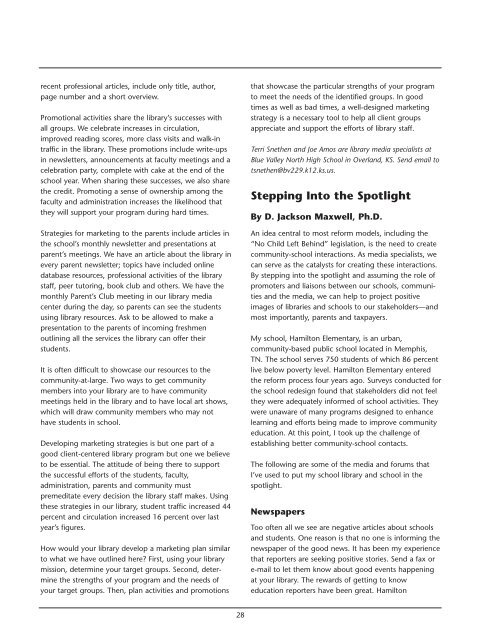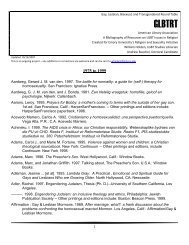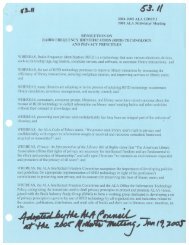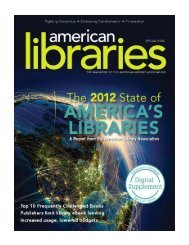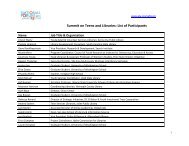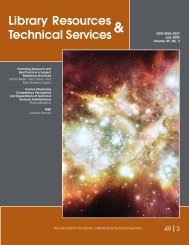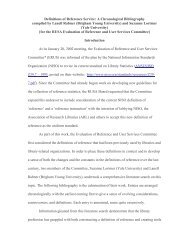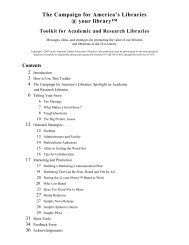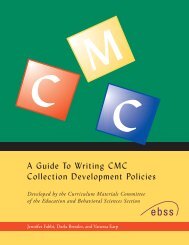Toolkit for School Library Media Programs - American Library ...
Toolkit for School Library Media Programs - American Library ...
Toolkit for School Library Media Programs - American Library ...
You also want an ePaper? Increase the reach of your titles
YUMPU automatically turns print PDFs into web optimized ePapers that Google loves.
ecent professional articles, include only title, author,<br />
page number and a short overview.<br />
Promotional activities share the library’s successes with<br />
all groups. We celebrate increases in circulation,<br />
improved reading scores, more class visits and walk-in<br />
traffic in the library. These promotions include write-ups<br />
in newsletters, announcements at faculty meetings and a<br />
celebration party, complete with cake at the end of the<br />
school year. When sharing these successes, we also share<br />
the credit. Promoting a sense of ownership among the<br />
faculty and administration increases the likelihood that<br />
they will support your program during hard times.<br />
Strategies <strong>for</strong> marketing to the parents include articles in<br />
the school’s monthly newsletter and presentations at<br />
parent’s meetings. We have an article about the library in<br />
every parent newsletter; topics have included online<br />
database resources, professional activities of the library<br />
staff, peer tutoring, book club and others. We have the<br />
monthly Parent’s Club meeting in our library media<br />
center during the day, so parents can see the students<br />
using library resources. Ask to be allowed to make a<br />
presentation to the parents of incoming freshmen<br />
outlining all the services the library can offer their<br />
students.<br />
It is often difficult to showcase our resources to the<br />
community-at-large. Two ways to get community<br />
members into your library are to have community<br />
meetings held in the library and to have local art shows,<br />
which will draw community members who may not<br />
have students in school.<br />
Developing marketing strategies is but one part of a<br />
good client-centered library program but one we believe<br />
to be essential. The attitude of being there to support<br />
the successful ef<strong>for</strong>ts of the students, faculty,<br />
administration, parents and community must<br />
premeditate every decision the library staff makes. Using<br />
these strategies in our library, student traffic increased 44<br />
percent and circulation increased 16 percent over last<br />
year’s figures.<br />
How would your library develop a marketing plan similar<br />
to what we have outlined here? First, using your library<br />
mission, determine your target groups. Second, determine<br />
the strengths of your program and the needs of<br />
your target groups. Then, plan activities and promotions<br />
28<br />
that showcase the particular strengths of your program<br />
to meet the needs of the identified groups. In good<br />
times as well as bad times, a well-designed marketing<br />
strategy is a necessary tool to help all client groups<br />
appreciate and support the ef<strong>for</strong>ts of library staff.<br />
Terri Snethen and Joe Amos are library media specialists at<br />
Blue Valley North High <strong>School</strong> in Overland, KS. Send email to<br />
tsnethen@bv229.k12.ks.us.<br />
Stepping Into the Spotlight<br />
By D. Jackson Maxwell, Ph.D.<br />
An idea central to most re<strong>for</strong>m models, including the<br />
“No Child Left Behind” legislation, is the need to create<br />
community-school interactions. As media specialists, we<br />
can serve as the catalysts <strong>for</strong> creating these interactions.<br />
By stepping into the spotlight and assuming the role of<br />
promoters and liaisons between our schools, communities<br />
and the media, we can help to project positive<br />
images of libraries and schools to our stakeholders—and<br />
most importantly, parents and taxpayers.<br />
My school, Hamilton Elementary, is an urban,<br />
community-based public school located in Memphis,<br />
TN. The school serves 750 students of which 86 percent<br />
live below poverty level. Hamilton Elementary entered<br />
the re<strong>for</strong>m process four years ago. Surveys conducted <strong>for</strong><br />
the school redesign found that stakeholders did not feel<br />
they were adequately in<strong>for</strong>med of school activities. They<br />
were unaware of many programs designed to enhance<br />
learning and ef<strong>for</strong>ts being made to improve community<br />
education. At this point, I took up the challenge of<br />
establishing better community-school contacts.<br />
The following are some of the media and <strong>for</strong>ums that<br />
I’ve used to put my school library and school in the<br />
spotlight.<br />
Newspapers<br />
Too often all we see are negative articles about schools<br />
and students. One reason is that no one is in<strong>for</strong>ming the<br />
newspaper of the good news. It has been my experience<br />
that reporters are seeking positive stories. Send a fax or<br />
e-mail to let them know about good events happening<br />
at your library. The rewards of getting to know<br />
education reporters have been great. Hamilton


